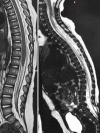Tethered Cord Syndrome After Myelomeningocele Repair: A Literature Update
- PMID: 33072445
- PMCID: PMC7560491
- DOI: 10.7759/cureus.10949
Tethered Cord Syndrome After Myelomeningocele Repair: A Literature Update
Abstract
Tethered cord syndrome (TCS) after myelomeningocele (MMC) repair (or secondary TCS) is a challenging condition characterized by neurological, orthopedic, and urological symptoms, which are combined with a low-lying position of the conus medullaris and damage to the stretched spinal cord owing to metabolic and vascular derangements. It has been reported that this syndrome affects, on average, 30% of children with MMC. In this review, we revisit the historical aspects of secondary TCS and highlight the most important concepts of diagnosis, treatment, and outcomes for secondary TCS as well as the current research regarding the impact of fetal MMC repair in the incidence and management of TCS. In the future, the development of synthetic models of TCS could shorten the learning curve of pediatric neurosurgeons, and research into the cellular proapoptotic features and increased inflammation biomarkers associated with TCS will also improve the treatment of this condition and minimize retethering of the spinal cord.
Keywords: fetal surgery; myelomeningocele; secondary tethered cord syndrome; tethered cord syndrome.
Copyright © 2020, Ferreira Furtado et al.
Conflict of interest statement
The authors have declared that no competing interests exist.
Figures




References
-
- Comparison of prenatal and postnatal management of patients with myelomeningocele. Cavalheiro S, da Costa MDS, Moron AF, Leonard J. Neurosurg Clin N Am. 2017;28:439–448. - PubMed
-
- Congress of Neurological Surgeons systematic review and evidence-based guideline on the incidence of tethered cord syndrome in infants with myelomeningocele with prenatal versus postnatal repair. Mazzola CA, Tyagi R, Assassi N, et al. Neurosurgery. 2019;85:0. - PubMed
-
- Myelomeningocele: surgical trends and predictors of outcome in the United States, 1988-2010. Kshettry VR, Kelly ML, Rosenbaum BP, Seicean A, Hwang L, Weil RJ. J Neurosurg Pediatr. 2014;13:666–678. - PubMed
-
- Tethered cord syndrome. Agarwalla PK, Dunn IF, Scott RM, Smith ER. Neurosurg Clin N Am. 2007;18:531–547. - PubMed
-
- Operative nuances of myelomeningocele closure. Perry VL, Albright AL, Adelson PD. Neurosurgery. 2002;51:719–723. - PubMed
Publication types
LinkOut - more resources
Full Text Sources
